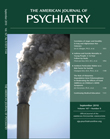Ambient Particulate Matter as a Risk Factor for Suicide
Abstract
Objective:
The authors assessed the relationship between exposure to ambient particulate matter and suicide in urban settings during a 1-year period.
Method:
The association between particulate matter and suicide was determined using a time-stratified case-crossover approach in which subjects served as their own controls. All suicide cases (4,341) in 2004 that occurred in seven cities in the Republic of Korea were included. Hourly mean concentrations of particulate matter ≤10 μm in aerodynamic diameter (at 106 sites in the seven cities) and particulate matter ≤2.5 μm in aerodynamic diameter (at 13 sites in one city) were measured. The percent increase in suicide risk associated with an interquartile range increase in particulate matter was determined by conditional logistic regression analysis after adjusting for national holidays and meteorological factors. Subgroup analysis was performed after stratification by underlying disease (cardiovascular disease, diabetes mellitus, chronic obstructive pulmonary disease, cancer, and psychiatric illness).
Results:
The largest associations were a 9.0% increase (95% CI=2.4–16.1) and a 10.1% (95% CI=2.0–19.0) increase in suicide risk related to an interquartile range increase in particulate matter ≤10 μm (average of 0 to 2 days prior to the day of suicide) and particulate matter ≤2.5 μm (1 day prior to the day of suicide), respectively. Among individuals with cardiovascular disease, a significant association between particulate matter ≤10 μm (average of 0 to 2 days prior to the day of suicide) and suicide was observed (18.9%; 95% CI=3.2–37.0).
Conclusions:
Conclusions: A transient increase in particulate matter was associated with increased suicide risk, especially for individuals with preexisting cardiovascular disease.



